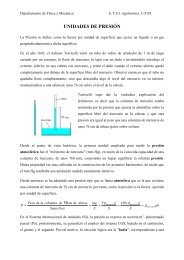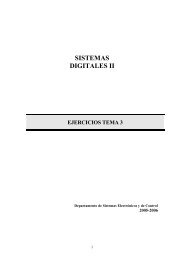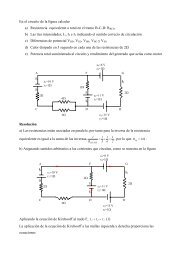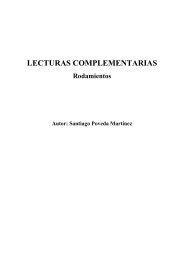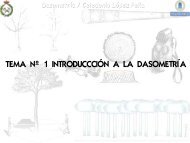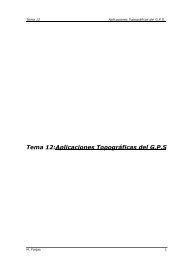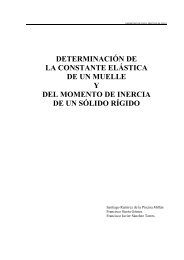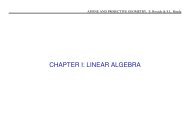Computational Logic - OCW UPM
Computational Logic - OCW UPM
Computational Logic - OCW UPM
You also want an ePaper? Increase the reach of your titles
YUMPU automatically turns print PDFs into web optimized ePapers that Google loves.
<strong>Computational</strong> <strong>Logic</strong><br />
Herbrand’s Theorem<br />
Damiano Zanardini<br />
<strong>UPM</strong> European Master in <strong>Computational</strong> <strong>Logic</strong> (EMCL)<br />
School of Computer Science<br />
Technical University of Madrid<br />
damiano@fi.upm.es<br />
Academic Year 2009/2010<br />
D. Zanardini (damiano@fi.upm.es) <strong>Computational</strong> <strong>Logic</strong> Ac. Year 2009/2010 1 / 1
Motivationp<br />
The theorem<br />
Herbrand’s theorem is the basis for most proof techniques in automatic theorem<br />
proving (ATP)<br />
How is it useful?<br />
in order to decide the (un)satisfiability of a formula F , it is enough to study<br />
its Herbrand interpretations<br />
it is necessary to have an ordered and exhaustive way to produce the<br />
Herbrand interpretations<br />
this can be done by means of semantic trees<br />
D. Zanardini (damiano@fi.upm.es) <strong>Computational</strong> <strong>Logic</strong> Ac. Year 2009/2010 2 / 1
Semantic trees (Robinson ’68, Kowalski-Hayes ’69)p<br />
Definition<br />
Let HB(F ) = {A1, A2, A3, ..} be the Herbrand base of a formula F in clause form:<br />
a semantic tree for F is a binary tree where<br />
0<br />
1<br />
2<br />
3<br />
every level of the tree corresponds to a ground atom of HB(F )<br />
the two links from a node at level i − 1 to nodes at level i are labeled, resp.,<br />
with Ai and ¬Ai<br />
A1<br />
¬A1<br />
A2 ¬A2 A2 ¬A2<br />
A3 ¬A3 A3 ¬A3 A3 ¬A3 A3 ¬A3<br />
D. Zanardini (damiano@fi.upm.es) <strong>Computational</strong> <strong>Logic</strong> Ac. Year 2009/2010 3 / 1
Semantic trees (Robinson ’68, Kowalski-Hayes ’69)p<br />
Completeness, failure nodes and closed trees<br />
a semantic tree is complete if every path from the root to a leaf contains Ai<br />
or ¬Ai for all Ai ∈ HB(F )<br />
a complete tree for F contains all Herbrand interpretations of F<br />
given a node N, I (N) is the set of all literals which label the path from the<br />
root to N<br />
☞ I (N) partially represents a Herbrand interpretation<br />
a node N is a failure node (denoted by ) if I (N) makes some ground<br />
instance of some clause false, and I (N ′ ) for any predecessor N ′ of N does not<br />
☞ that is, I (N ′ ) does not falsify any ground instance of any clause<br />
a tree is closed iff all paths from the root to a leaf contain a failure node<br />
a closed tree has level n if n is the maximum length of paths from the root to<br />
a failure node<br />
D. Zanardini (damiano@fi.upm.es) <strong>Computational</strong> <strong>Logic</strong> Ac. Year 2009/2010 3 / 1
Semantic trees (Robinson ’68, Kowalski-Hayes ’69)p<br />
Example: F = {¬q(x) ∨ r(x), p(x) ∨ ¬r(x), ¬p(x)}<br />
H(F ) = {a} HB(F ) = {p(a), q(a), r(a)}<br />
p(a) ¬p(a)<br />
<br />
q(a) ¬q(a) q(a) ¬q(a)<br />
r(a) ¬r(a) r(a) ¬r(a) r(a) ¬r(a) r(a) ¬r(a)<br />
<br />
cm cm cm cm cm cm cm m<br />
= failure node, m = model, cm = countermodel<br />
D. Zanardini (damiano@fi.upm.es) <strong>Computational</strong> <strong>Logic</strong> Ac. Year 2009/2010 3 / 1
Semantic trees (Robinson ’68, Kowalski-Hayes ’69)p<br />
Example: F = {p(y), q(a) ∨ ¬p(f (x)), ¬q(x)}<br />
H(F ) = {f n (a) | n ≥ 0}<br />
HB(F ) = {p(t) | t ∈ H(F )} ∪ {q(t) | t ∈ H(F )}<br />
every Herbrand interpretation falsifies some instance of some clause, so that<br />
F is unsatisfiable<br />
p(f (a))<br />
p(a) ¬p(a)<br />
q(a) ¬q(a) q(a)<br />
<br />
1 ¬q(a)<br />
<br />
2<br />
¬p(f (a))<br />
p(f (a))<br />
<br />
3<br />
¬p(f (a))<br />
<br />
4<br />
D. Zanardini (damiano@fi.upm.es) <strong>Computational</strong> <strong>Logic</strong> Ac. Year 2009/2010 3 / 1<br />
p(f (a))<br />
¬p(f (a))<br />
p(f (a))<br />
¬p(f (a))
Semantic trees (Robinson ’68, Kowalski-Hayes ’69)p<br />
Example: F = {p(y), q(a) ∨ ¬p(f (x)), ¬q(x)}<br />
H(F ) = {f n (a) | n ≥ 0}<br />
HB(F ) = {p(t) | t ∈ H(F )} ∪ {q(t) | t ∈ H(F )}<br />
every Herbrand interpretation falsifies some instance of some clause, so that<br />
F is unsatisfiable<br />
p(f (a))<br />
<br />
1 ¬p(f (a))<br />
...<br />
...<br />
q(a) ¬q(a)<br />
...<br />
...<br />
p(f (a)) ¬p(f (a))<br />
D. Zanardini (damiano@fi.upm.es) <strong>Computational</strong> <strong>Logic</strong> Ac. Year 2009/2010 3 / 1<br />
...<br />
<br />
2<br />
...<br />
...<br />
<br />
3<br />
...
Semantic trees (Robinson ’68, Kowalski-Hayes ’69)p<br />
Note on cardinalities<br />
We want to use semantic trees in order to enumerate Herbrand interpretations<br />
yet, how many interpretations can we have?<br />
how it is possible to enumerate them?<br />
D. Zanardini (damiano@fi.upm.es) <strong>Computational</strong> <strong>Logic</strong> Ac. Year 2009/2010 3 / 1
Herbrand’s theoremp<br />
Lemma (König’s Lemma)<br />
In an infinite tree with finite branching (i.e., such that every node has a finite<br />
number of children), there must exist an infinite path from the root<br />
Proof.<br />
(typical result in tree theory)<br />
D. Zanardini (damiano@fi.upm.es) <strong>Computational</strong> <strong>Logic</strong> Ac. Year 2009/2010 4 / 1
Herbrand’s theoremp<br />
Theorem<br />
C is unsatisfiable iff its complete semantic tree is closed<br />
Proof.<br />
C is unsatisfiable<br />
↔ all Herbrand interpretations make C false<br />
↔ all paths from the root contain a failure node<br />
↔ the tree is closed<br />
D. Zanardini (damiano@fi.upm.es) <strong>Computational</strong> <strong>Logic</strong> Ac. Year 2009/2010 4 / 1
Herbrand’s theoremp<br />
Lemma<br />
A complete semantic tree is closed iff a finite tree is obtained by pruning all<br />
successors of failure nodes<br />
Proof (→).<br />
❶ the complete semantic tree is closed<br />
❷ suppose the pruned tree were not finite<br />
❸ then, by König’s lemma, there exists an infinite path<br />
❹ such infinite path would not have any failure nodes<br />
❺ the tree would not be closed: contradiction between ❶ and ❷<br />
❻ the pruned tree is finite<br />
Proof (←).<br />
(easy)<br />
D. Zanardini (damiano@fi.upm.es) <strong>Computational</strong> <strong>Logic</strong> Ac. Year 2009/2010 4 / 1
Herbrand’s theoremp<br />
Theorem (Herbrand’s theorem (Ph.D. Thesis, 1929))<br />
A set of clauses C is unsatisfiable iff there exists a finite set of ground instances of<br />
C clauses which is unsatisfiable<br />
Proof (→).<br />
❶ C is unsatisfiable<br />
❷ there exists a finite semantic tree for C whose every leaf is a failure node (by<br />
❶ and the above results)<br />
❸ every path falsifies at least one ground instance (by ❷)<br />
❹ since the tree is finite, collecting one (falsified) instance for every failure node<br />
gives a finite set S<br />
❺ all Herbrand interpretations falsify some instances in S<br />
❻ such finite set S of instances is unsatisfiable (by ❺)<br />
(why Herbrand interpretations of C are enough to prove UNSAT (S)?)<br />
D. Zanardini (damiano@fi.upm.es) <strong>Computational</strong> <strong>Logic</strong> Ac. Year 2009/2010 4 / 1
Herbrand’s theoremp<br />
Theorem (Herbrand’s theorem (Ph.D. Thesis, 1929))<br />
A set of clauses C is unsatisfiable iff there exists a finite set of ground instances of<br />
C clauses which is unsatisfiable<br />
Proof (←).<br />
❶ there exists an unsatisfiable finite set S of ground instances of C clauses<br />
❷ suppose C be satisfiable: then, some Herbrand interpretation would verify<br />
every instance of every clause<br />
❸ in particular, such interpretation would verify all instances in S<br />
❹ S would be satisfiable (by ❸): contradiction between ❶ and ❷<br />
❺ C is unsatisfiable (by ❹)<br />
D. Zanardini (damiano@fi.upm.es) <strong>Computational</strong> <strong>Logic</strong> Ac. Year 2009/2010 4 / 1
Herbrand’s theoremp<br />
Example: C = {p(y), q(a) ∨ ¬p(f (x)), ¬q(x)}<br />
p(f (a))<br />
<br />
1 ¬p(f (a))<br />
...<br />
...<br />
q(a) ¬q(a)<br />
...<br />
...<br />
...<br />
in 1, the instance ¬q(a) of ¬q(x) is falsified<br />
p(f (a)) ¬p(f (a))<br />
in 2, the instance q(a) ∨ ¬p(f (a)) of q(a) ∨ ¬p(f (x)) is falsified<br />
in 3, the instance p(f (a)) of p(y) is falsified<br />
→ this set of ground instances is unsatisfiable<br />
→ Herbrand’s theorem guarantees that C is unsatisfiable<br />
D. Zanardini (damiano@fi.upm.es) <strong>Computational</strong> <strong>Logic</strong> Ac. Year 2009/2010 4 / 1<br />
<br />
2<br />
...<br />
...<br />
<br />
3<br />
...
Herbrand’s theoremp<br />
The theorem suggests a method<br />
Given a set C of clauses, generate its ground instances incrementally, and put<br />
them in a set until the whole set becomes unsatisfiable:<br />
B = ∅;<br />
while (B is satisfiable)<br />
b = new-instance(C);<br />
B = B ∪ {b};<br />
Implementations of Herbrand’s theorem<br />
It is necessary to choose a strategy for generating instances<br />
method of Gilmore (1960)<br />
method of Davis-Putnam (1960)<br />
resolution method by Robinson (1965)<br />
D. Zanardini (damiano@fi.upm.es) <strong>Computational</strong> <strong>Logic</strong> Ac. Year 2009/2010 4 / 1




